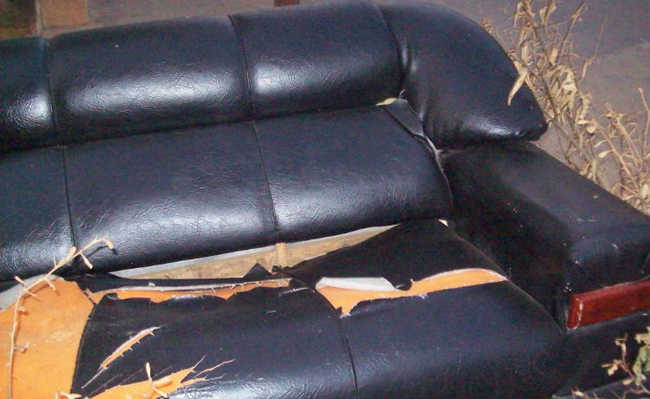What is a sofa made of? Can it be recycled?
Sofa components can be recycled or reused

We are so used to sitting on it that we rarely think what the sofa is made of. Knowing what makes up an object is the first step to find out if it can be harmful to your health and the environment, in addition to being fundamental when disposing of it.
Sofas are usually made of a wooden frame, springs, a layer of strong fabric, layers of foam, acrylic blanket, elastic straps (an interweaving of latex mixed with plastic) located on the inside of the sofa, and the covering fabrics. So, basically, the sofa is formed by a structure, the filling and the covering.
All products, the furniture included there, go through the production, distribution, use and dismantling processes. To produce a piece of furniture such as a sofa, materials and energy are needed; to distribute it, packaging and a means of transport are needed, which also requires energy and emits pollutants; during use, it may require some maintenance, such as replacing some component part (which generates waste; and, finally, at some point it will lose use, becoming garbage. When that happens, what happens with the materials that make up the sofa? Are they polluting? What is the best way of disposal? Is the sofa recyclable or can I at least do a conscious disposal?
First, the disposal of a piece of furniture used as a sofa cannot take place on public roads, vacant lots or streams. Irregular disposal is considered an environmental crime subject to a fine of up to R$14,000. When disposed of irregularly, the sofa contributes to flooding by obstructing water passages. Another point of concern is its decomposition time, let's understand why.
Structure
Wood is naturally a biodegradable material, but the structure of the sofa is made up of wooden boards (MDF, chipboard, laminates), which are bonded with resins that contain a significant percentage of formaldehyde in its composition. Formaldehyde is a preservative, that is, it prevents the growth of various microorganisms - in this way, it makes the wooden boards take longer and longer to degrade, taking up to 13 years to complete the process completely (learn more about the formaldehyde here).
In addition to this problem, during the manufacturing process of wooden boards, formaldehyde is released in the form of smoke, being extremely toxic and harmful to workers. When illegal disposal occurs, many people burn sofas. Due to resins made with formaldehyde, the smoke released is very toxic. Unlike occupational exposure, when the sofa is burned outdoors, people are not protected with any type of safety equipment to filter toxic smoke, being directly affected.
The springs that make up some sofas are usually made of steel. Steel is not biodegradable and, due to the action of rain and wind, it takes over 100 years to decompose. Imagine if everyone discarded the material (which is recyclable) irregularly?
Filling
In the stuffing or upholstery part of the sofa, about five different types of materials are added, generally foams of different thickness and purpose. The main foam used is high density polyurethane - this petroleum-based plastic contains components that are toxic to health and are extremely volatile (volatile organic compounds). Polyurethane is not biodegradable and can take over 100 years to degrade due to the action of rain and wind. The material also cannot be melted because it does not return to a stage where another foam can be made. The known recycling for polyurethane is mechanical, that is, the one that transforms the polyurethane into very small parts that can be used in the manufacture of asphalts for running, garbage bags, floors, hoses, fibers, packaging (except for food), conduits and car parts. So if you correctly dispose of your sofa, this is the most likely destination for the foam (learn more about polyurethane here).
Roof
This part is the most visible part of a sofa and consists of the finishing process. On the roof, different types of materials can be used, such as jute, cotton, leather, polyester. Leather is naturally biodegradable because it is of organic origin, however, due to the treatment processes to which it is submitted (chromium bath), the decomposition time can be extended. But it is worth remembering that the material comes from the suffering and death of animals, and is not, therefore, a type of cover eco-friendly (friendly ecological). Due to the durability granted to leather, it is possible to reuse it when the sofa can no longer be used, removing the leather to make other artifacts.
Jute fabric is the fiber of the plant with the same name, it requires less chemicals in its treatment and can be reused for other purposes (crafts) after its use as a sofa cover.
Cotton fabrics are mostly used in the form of sofa covers because they are very easy to retain dirt. Cotton pieces can be recycled through a fiber separation process, in which it is possible to produce other pieces with the recycled material. Currently there are companies that do this service.
Polyester-covered sofas are usually made of a cotton-polyester blend. Fabrics with this composition can also be recycled through mechanical fiber separation processes.
Now that you have this information, think twice before disposing of a sofa or other furniture in an inappropriate location and also before buying a new sofa. It is possible to recycle and reuse many sofa components, reducing waste and taking up less space in landfills.
Click here to find out where to dispose of your sofas and other antique furniture or use our pick-up service at your home:
Do you want to dispose of your object with a clear conscience and without leaving the house?
To find out which cities the service is available in, click here.










